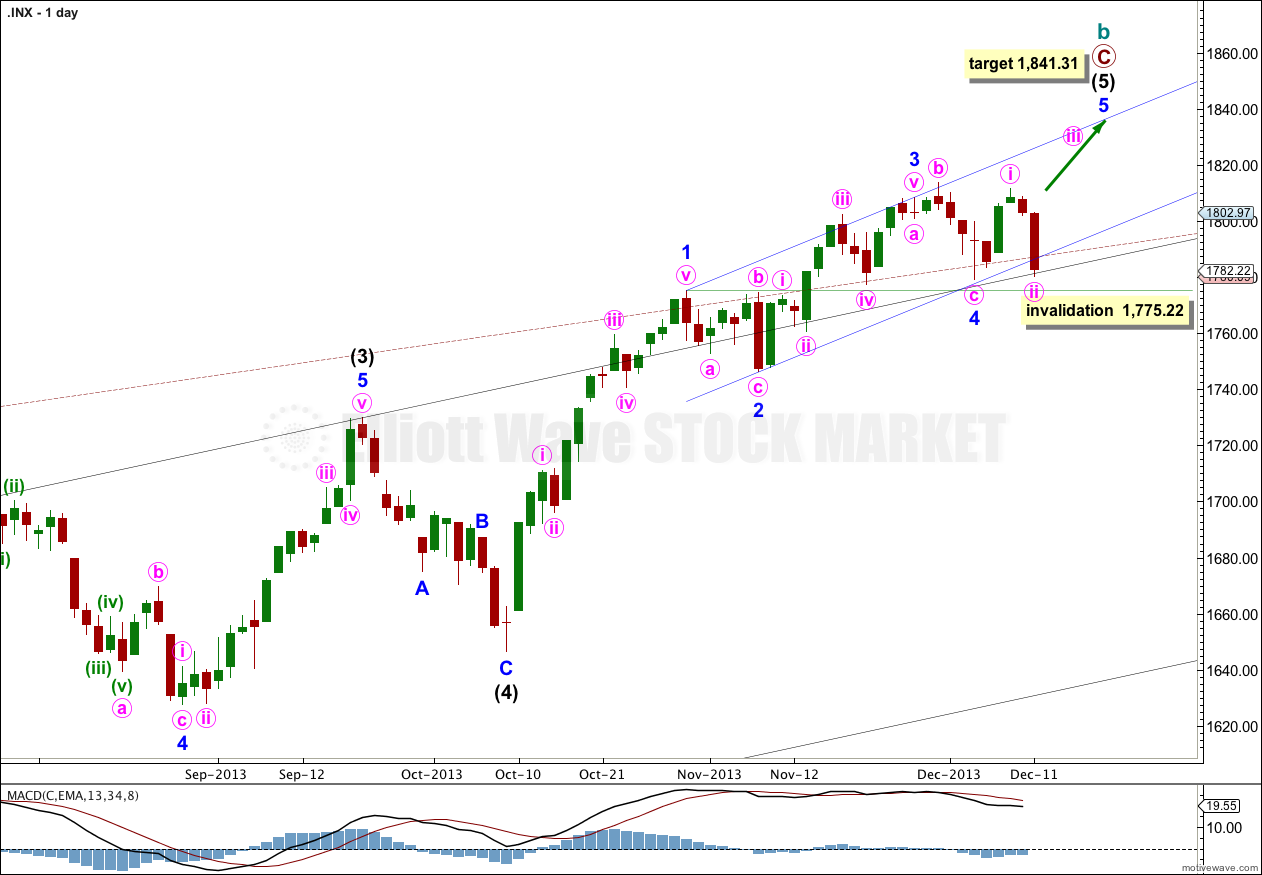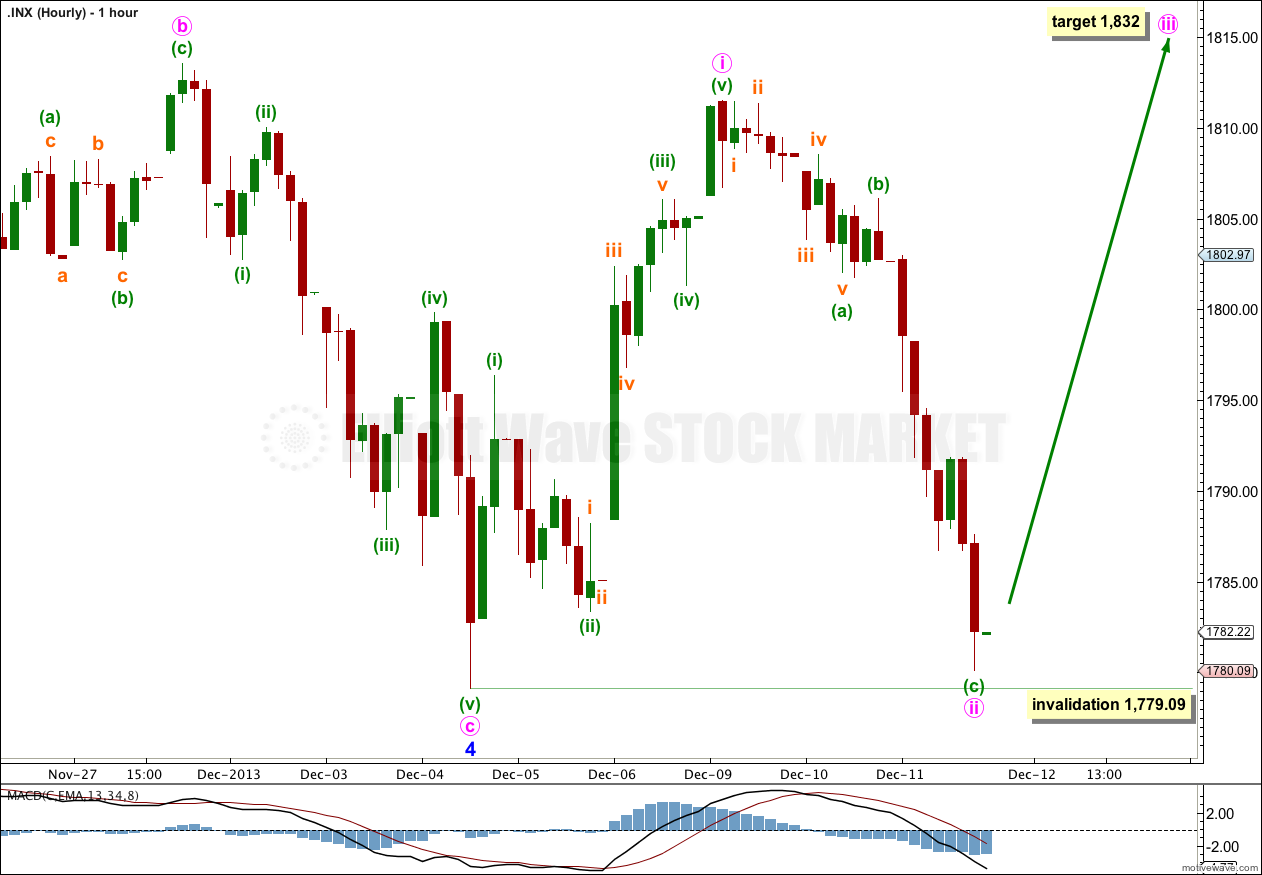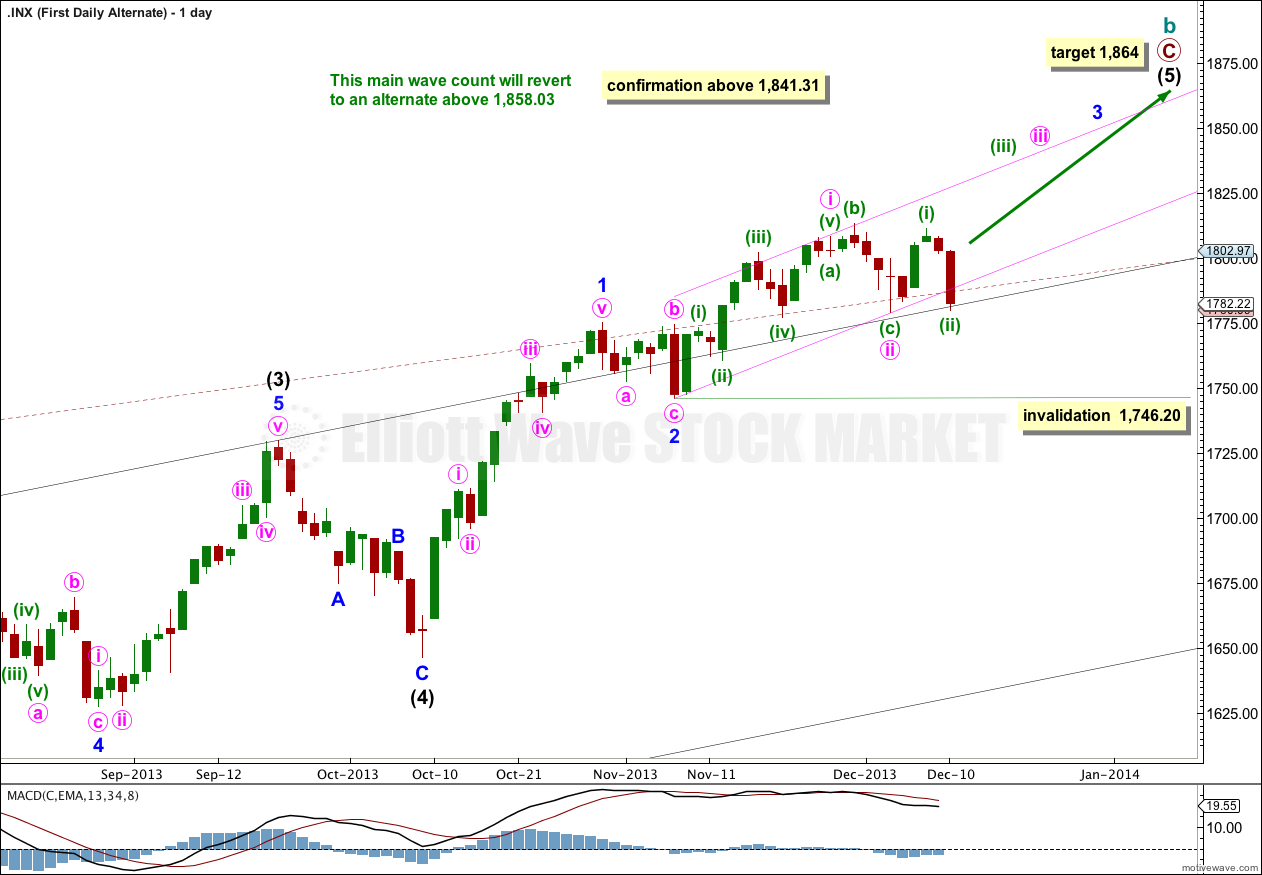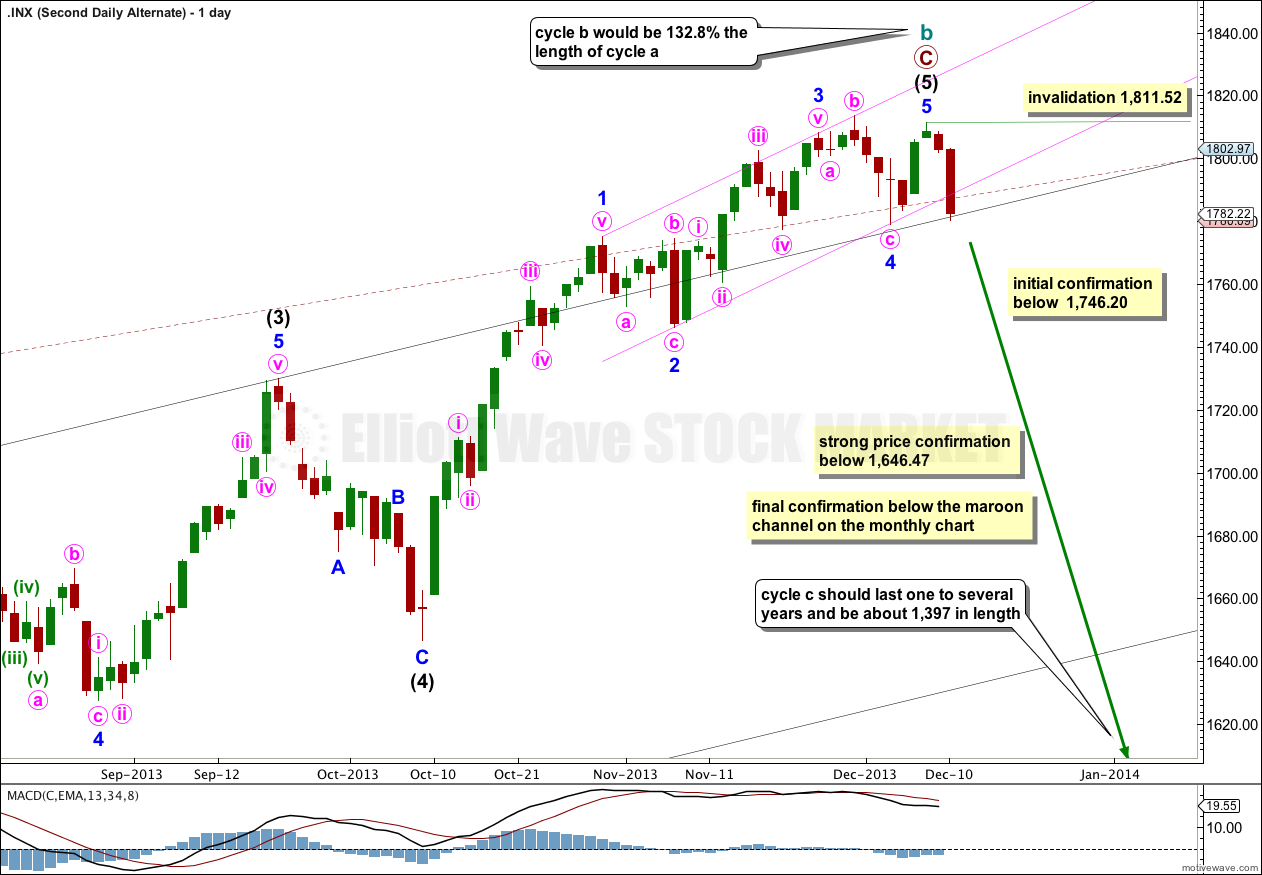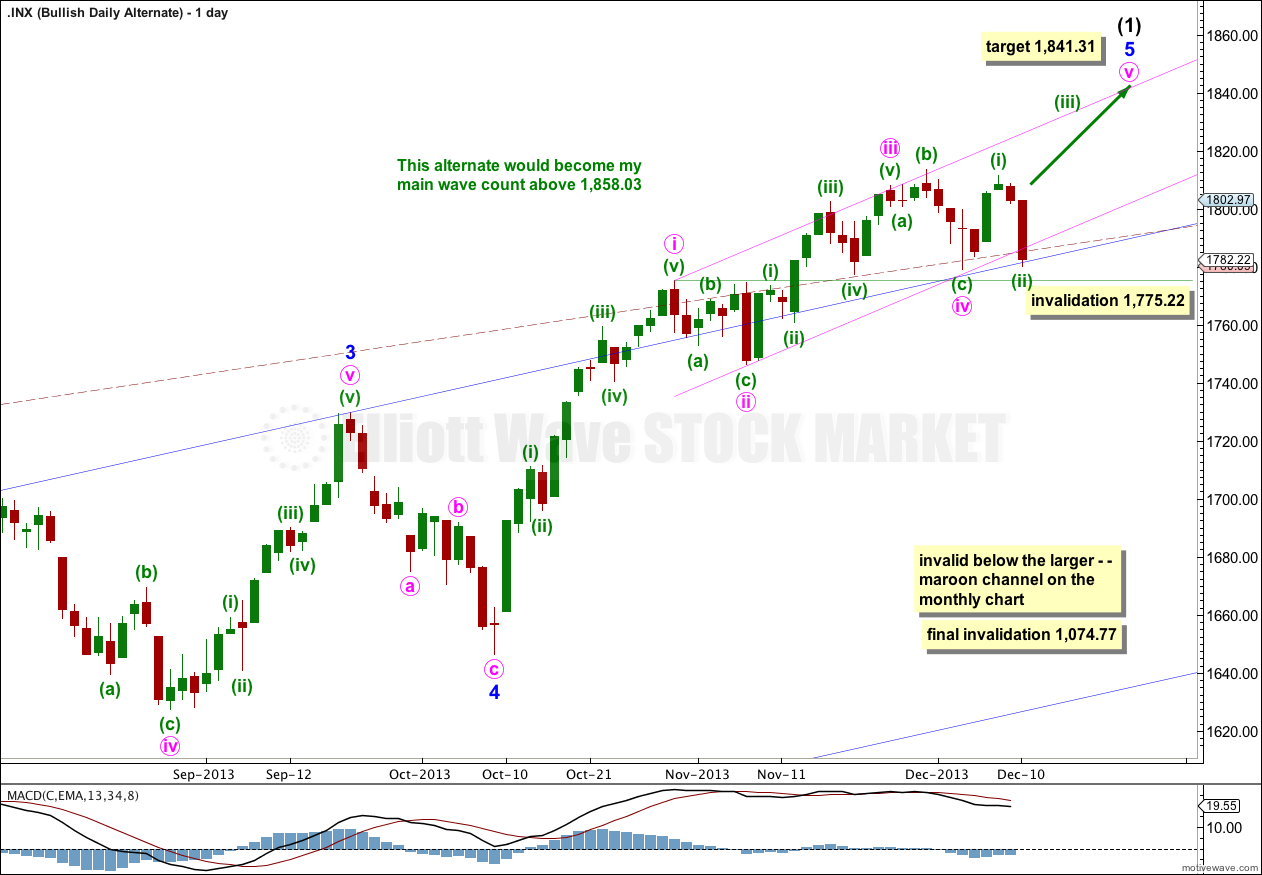I had expected more downwards movement to complete a second wave correction, but not as much as we have got, and I had expected it to be over during the morning of Wednesday’s session.
The depth of this downwards movement over the last two days has made me step back and rethink the wave count at the daily chart level. I now have three scenarios for you, alongside the same bullish alternate.
Click on the charts below to enlarge.
Main Wave Count.
This wave count has a higher probability than the alternate. Upwards movement over the last 4 1/2 years subdivides best as a zigzag. If something is “off” about the supposed recovery then it must be a B wave because there is plenty that is off in this scenario in terms of social mood.
Intermediate wave (5) may be incomplete, with minor waves through to 4 complete.
Even though momentum within minor wave 3 failed slightly to exceed that of minor wave 1, the channel breach of the blue channel during today’s session reduces the probability of the first alternate below. It may be that minor wave 3 is over. Minor wave 5 may not exceed equality with minor wave 3. Minor wave 5 would reach equality with minor wave 3 at 1,841.31.
I have drawn a channel about intermediate wave (5) first with a trend line from the highs of minor waves 3 to 1, then a copy upon the low of minor wave 2. This perfectly shows where minor wave 4 has found support.
Downwards movement subdivides best as a five wave impulse, but it also may be a zigzag. Minuette wave (c) would be just 1.2 points longer than 2.618 the length of minuette wave (a).
At 1,832 minute wave iii would reach 1.618 the length of minute wave i.
Any further movement below 1,779.09 would invalidate this wave count because minute wave ii may not move beyond the start of minute wave i.
First Alternate Wave Count.
It is still possible that minor wave 3 is extending. However, downwards movement has breached the acceleration channel about minute waves i and ii. Second wave corrections rarely breach acceleration channels drawn about the first and second wave of one degree higher. For this reason this wave count is now relegated to alternate status, and its probability has reduced.
At 1,864 intermediate wave (5) would reach equality in length with intermediate wave (1).
At 1,858.03 cycle wave b would reach 138% the length of cycle wave a. At super cycle degree this wave count sees a large expanded flat unfolding. Within the expanded flat the maximum common length of cycle wave b is up to 138% the length of cycle wave a. When cycle wave b becomes longer than this then the probability that an expanded flat is unfolding decreases. At that stage I would swap over the main and alternate daily wave counts.
Second Alternate Wave Count.
We should always assume the trend remains the same, until proven otherwise. “The trend is your friend”. This wave count is possible but we have absolutely no confirmation of a trend change at cycle degree.
Within cycle wave b primary wave C is 47.06 longer than equality with primary wave A. Upwards movement may have found final resistance at the upper edge of the maroon channel drawn about the whole of cycle wave b from its start at 666.79.
Cycle wave b is 132.8% the length of cycle wave a, within the common length of 100% to 138% for a flat correction. Because cycle wave b is over 105% the length of cycle wave a this would be an expanded flat which normally expects a C wave to move substantially beyond the end of the A wave. Movement well below 666.79 would be expected for this wave count.
Ratios within primary wave C are: intermediate wave (3) is just 0.76 points longer than 2.618 the length of intermediate wave (1), and intermediate wave (5) has no Fibonacci ratio to either of intermediate waves (1) or (3).
Ratios within intermediate wave (5) are: minor wave 3 has no Fibonacci ratio to minor wave 1, and minor wave 5 is just 2.05 points longer than 0.236 the length of minor wave 1.
I will keep charting this possibility as an alternate. It requires initial confirmation with movement below 1,746.20.
Final price confirmation of a trend change would come with movement below 1,646.47. At that stage both this wave count and the bullish alternate would be correct and this would be my main wave count.
For this bearish wave count the big maroon channel on the monthly chart needs to be breached. If that occurs then the bullish alternate would be discarded and this would be my only wave count.
Within cycle wave c no second wave correction may move beyond the start of its first wave. This wave count is invalidated with movement above 1,811.52.
Bullish Alternate Wave Count.
It is possible that a new cycle degree bull market began at 666.79. So far it is not yet halfway through, and I would expect it to last for a few years (at least five more years and probably longer).
At some stage then the current upwards impulse, labeled intermediate wave (5) for the main wave count and minor wave 5 for this alternate, will be completed. At that stage both wave counts would expect a trend change. The main wave count would expect a huge cycle degree trend change, and this alternate would expect an intermediate degree trend change. If the downwards movement subdivides as a three and remains within the maroon channel then this alternate would be preferred. If it breaches the channel this alternate would be discarded.
The maroon – – – channel is an acceleration channel drawn about primary waves 1 and 2 on the monthly chart (it is drawn in exactly the same way on the main wave count, but there it is termed a corrective channel). I would not expect intermediate wave (2) to breach this channel because a lower degree (intermediate) wave should not breach an acceleration channel of a higher degree (primary) first and second wave.
The daily chart shows the structure of minor wave 5. It is incomplete. Targets are the same because they are calculated using the same wave lengths as the main wave count. This bullish alternate does not diverge from the main wave count at this stage, and it will not for some weeks (or months) to come.

